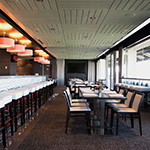Urban living is on the rise. Once again drawn to the energy and unity that dense districts can provide, young people are moving into townhomes and high-rises in the heart of our country’s great cities in increasing numbers. The most recent census reveals that metro areas with more than a million citizens are growing by 1.1 percent, beating suburban areas by 0.2 percent.
It’s a huge reversal from previous decades that already has experts ready with theories. Young people, they say, have perhaps been driven back into cities by the recession. After all, city dwelling naturally provides connectedness; everything from friends to varied entertainment and dining options is within reach. Also, daily expenses are often lower because walking, biking, public transportation, and apartment living reduce fuel and energy costs.
 Whatever the reason for the trend, Hunt Companies is going all in on it. The large and diversified real estate operator has announced its intention to build Moda, an upscale apartment complex in Dallas’s Victory Park neighborhood. According to Aaron Docsa, the firm’s vice president of construction, the 263-unit building, slated for occupancy in February 2014, is specifically designed to attract the younger professionals and families who are already flocking to the area.
Whatever the reason for the trend, Hunt Companies is going all in on it. The large and diversified real estate operator has announced its intention to build Moda, an upscale apartment complex in Dallas’s Victory Park neighborhood. According to Aaron Docsa, the firm’s vice president of construction, the 263-unit building, slated for occupancy in February 2014, is specifically designed to attract the younger professionals and families who are already flocking to the area.
The district’s development was catalyzed by the American Airlines Center, which opened in 2001 and is now the home of the NBA’s Dallas Mavericks. The multievent arena is just one block from the Moda site. “We are providing housing units for people who want to be right down where the action is,” Docsa says. He’s betting that a class-A facility with 3,500 feet of retail space, amenities surpassing midrise standards, an infinity-edge pool, private patios, and a rooftop terrace will prove too hard for buyers to resist.
Historically, Hunt has acted as the majority equity partner in each of its deals, and it has teamed with managing partner Alamo Manhattan to complete Moda. Hunt and its affiliate building company will handle construction duties for the high-density urban-infill project. Docsa travels the country to be on-site for critical Hunt projects, and he went to Dallas the day his company broke ground on Moda in late 2012. He’s managing the overall day-to-day operations and is on schedule to deliver 20 units on the plaza pool deck by February 2014.
The pool, built atop a concrete parking garage, was one of Docsa’s biggest challenges. Its infinity edge, surrounded by glass and steel railing and fire pits, creates an inviting atmosphere with a stunning view of the Dallas skyline, but its complex structural geo-foam layout and installation required the planning of intricate plumbing and drainage systems. The scheduling of the work and the hoisting of materials prior to crane demobilization were especially difficult, given the project’s layout on a small, tight lot surrounded by parks and roads. “We’re basically building an eight-story apartment complex utilizing commercial-high-rise-style planning and scheduling practices,” Docsa says.
His group also had to contend with 32 feet of solid rock at the site’s north end. Thanks to good subcontractor selection, though, Docsa was able to find a special team that demolished and removed the stone. “We don’t always hire the subcontractors with the lowest price,” he says. “We hire the most qualified subs with the right combination of price and experience. Any challenge can be overcome with the right subs.” For Moda, Docsa looked for subs who had experience with downtown, high-density sites.
Docsa worked with both the subs and his employees to determine the most cost-effective means to get materials into the building at elevated heights. Hunt’s decision to employ wood-frame construction prevented the use of a commercial-type scaffold system, and limited space made a hoist system impossible, so the company turned to a tower crane, supplemented by temporary use of the building’s elevators. “Elevator installation became critical because they had to be operational prior to the start of interior doors, cabinets, and other features,” Docsa says.
His group persevered, and Docsa believes the project’s little details and special touches (including full-size washers and driers) will help when it comes to marketing. Hunt is creating a building that complements its surroundings, and its units are renting in the same price-per-square-foot range as others in the area. Presales began last December as Dallas’s downtown district continues to sing its siren song to prospective renters.


to use a tower crane to finish the tight build.
![“[Because of the tight lot], we’re basically building an eight-story apartment complex utilizing commercial-high-rise-style planning and scheduling practices,” says Aaron Docsa, VP of construction.](https://americanbuildersquarterly.com/install/wp-content/uploads/2013/12/11050_VICTORY_3D_RENDERINGS_MULTI-PDF-6_cropped.jpg)


